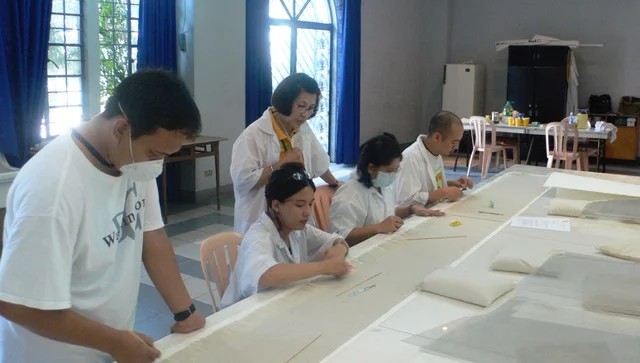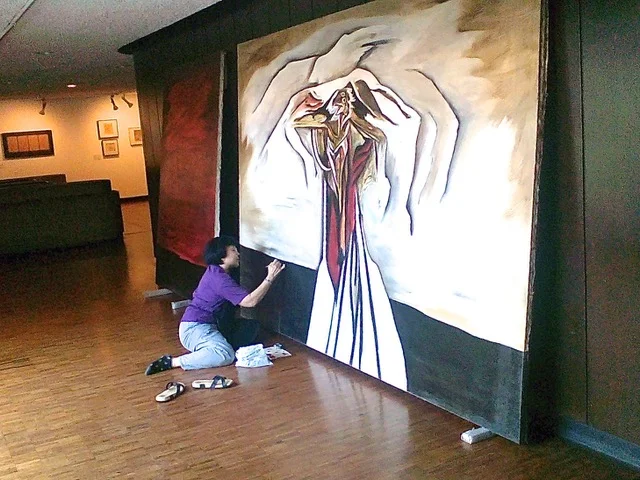June Dalisay, Art Healer
/Members of ACES, a team Dalisay established in 2001, work on a Botong Francisco mural.
“I love my work because it gives me the opportunity to see artworks that have never been seen by the public,” says Dalisay of her unique profession. “I am an artist and I find it fascinating to see up close and personal beautiful pieces done by the masters.”
Dalisay’s creative inclination began early in childhood. Her parents encouraged a simple lifestyle for Dalisay. While both her father and mother hailed from Iloilo, a province in the Visayas in the Philippines, Dalisay grew up with her two siblings in Quezon City. “We created our own toys and entertained ourselves using whatever there was in the house: a bahay-bahayan (playing house) in the garden using bed sheets; tin cans transformed into carts with wheels; guava branches made into tirador or slingshots, and old newspaper into kites and airplanes,” she recalls.
June Poticar-Dalisay
She knew she always wanted to be an artist. “I remember I would fill the blank side of colored plates of the Webster dictionary with drawings. My parents noticed I had talent and enrolled me in art classes at the young age of 10.”
Dalisay completed her primary and secondary education at the University of the Philippines, Diliman campus and studied for a Bachelor of Fine Arts degree, majoring in advertising in 1967 at the same school. Her interest in the arts grew through the years and, keen to learn, she found herself cultivating all the industry had to offer, which included the principles of art conservation.
It was a fortuitous encounter, which introduced Dalisay to art restoration and conservation. She attended a public-art lecture on the topic in 1993 sponsored by the Australian Center, and was enthralled by the speaker. “Listening to this conservator sparked my interest in art conservation immensely,” she remembers. There was no looking back.
Retouching a mural by Jaime de Guzman from the CCP Collection copy
“I met new friends from the National Museum and agencies involved in historic preservation and finally got in as a participant in an intensive training program in 1999, sponsored by the National Museum, NCCA and Agencia Española de Cooperacion International.”
To further her learning, Dalisay also visited conservation labs in Singapore and Thailand. “I met, talked and observed other conservators at work and discussed conservation issues and problems with them,” she says.
Studying the conditions of art is a meticulous and scientific process. Dalisay attributes her knowledge, value for introspection and experience to teachers who have guided her through the years. “I trained under Spanish conservators, experts who helped me understand the different properties of materials and how these materials react to the constantly changing environment and vice-versa.”
Dalisay likens her restoration profession to that of a doctor. “It’s actually funny as I wanted to be a surgeon growing up,” she fondly recalls. “I would be the one to treat wounds and cuts on our pets.” Now, Dalisay sees art as an organism, equating the conservation and restoration process to surgery.
Sacred Heart of Mary, a 19th century oil on canvas during and after restoration
Sacred Heart of Mary restored
“A conservator should be able to do a scientific analysis and assessment of the physical condition of an object or artwork. It also entails teamwork with an artist, chemist, photographer, carpenter and if needed, an architect. It’s always good to have different sets of eyes when studying an object.”
While not always in the limelight, an art conservator is critical in the art narrative of a culture. By saving and restoring sacred collections, the value of the art object not only goes up, but the context by which it was created also endures. “Negative environmental conditions can wreak havoc or damage on certain pieces,” says Dalisay. “If left unsolved, these pieces will eventually deteriorate and will make restoration complicated, longer and expensive.”
Dalisay remembers projects that hold a special significance to her. “I will not forget my experience when we did a partial cleaning of Juan Luna’s Spoliarium. I felt such an energy emanating from the mural the moment I stepped into the hall. I was in awe and silent for a long time.” She also had challenging assignments, such as a 19th century painting of a young Christ. “The painting was practically in taters, thin canvas and the paint falling of. I would go to bed thinking about this puzzle. However, with the help of my team, we completed the restoration with flying colors.”
A restored 19th c. portrait of an old lady before and after restoration
Every day, Dalisay continues to exhibit fervor for the job. “It gives me satisfaction and happiness when I see my work appreciated by the client. I may never own these expensive paintings, but I get to look at them for many hours, realizing I have given these objects a new life,” she says.
Sharing her knowledge and expertise with others, she recommends some key characteristics and skills for any art conservator prospective. “One must be willing to learn, dirtying your hands with dust, mold, checking nooks and crannies, basically moving out of your comfort zone. One should know the meaning of respect in order to show respect for the art object. And more importantly, one must have integrity. There can’t be shortcuts. The process must be completed with diligence and honesty.”
Teaching art conservation and restoration is Dalisay’s current new advocacy. “I am now teaching and training a group of young men and women and transferring skills and knowledge to spur a new generation of responsible conservators to take over the practice,” she states proudly. “Phase II will take place in 2018 and will involve actual restoration of artworks using more complicated procedures.”
Many people and experiences have influenced Dalisay’s life perspectives and profession through the years but her greatest acknowledgment goes back to that of family. “My joyfulness and kindness; my generosity with what I have whether material or non-material; my compassion for life and living things, I can say with pride that all these I learned and cultivated because of my loving parents,” she expresses.
If these were a movie, someone like June Dalisay might not be the heroine. But she is a definitive role-player. Because of her passion, Philippine art is able to thrive and evolve in an enriching and inspiring way. She brings the past to the forefront and allows new generations to experience Philippine culture anew. Dalisay is shaping the country’s history in her own small way, and for that, Filipinos should all be grateful for her creative work.
Serina Aidasani divides her time between New York and Chicago. She works in marketing communications and public relations.
More earticles from Serina Aidasani









